Integrated Building Retrofit for Seismic Resilience and Environmental Sustainability: A Critical Review
Abstract
1. Introduction
2. Methodology
- Identification: The queries, as a combination of selected keywords, were run on the selected indices (based on the title, abstract, and stated keywords of peer-reviewed conference papers, journal papers, reviews, and indexed book chapters). This step resulted in 355 returns, Figure 1. These returns formed the main database.
- Screening and eligibility: The abstracts of papers were reviewed according to the inclusion-exclusion criteria explained above. Papers that focus solely on seismic or energy retrofit without integration were excluded (Figure 1). A core database of 54 papers was selected and detailed in Table A1. Figure 2 and Figure 3 show the distribution of the documents across their sources and years of publication.
- Inclusion and analysis: The papers in the core database were thoroughly reviewed, and a thematic analysis was conducted to identify key dimensions and develop codes that capture recurring patterns within each dimension.
- The analysis results were collated to produce a mapping of the literature on the dimensions of integrated seismic–environmental retrofit, as well as the challenges that face such interventions with potential solutions.
3. Analysis
3.1. Structural Dimension
3.2. Environmental Dimension
3.3. Social and Governance Dimension
3.4. Approach for Integrated Seismic–Environmental Retrofit
- Structural Performance Indices: Probabilities of collapse, drift thresholds, or downtime estimates. These remain fundamental for life-safety and resilience objectives.
- Lifecycle Environmental Indicators: Embodied carbon (kg CO2e), energy use (MJ or kWh), water footprint (L), and total material mass are among the most commonly cited.
- Socioeconomic Metrics: Repair costs, business interruption, displacement duration, and social vulnerability indices.
- Cost–Benefit Measures: Net present value (NPV) and cost–benefit ratios are frequently used for financial comparisons.
- Intangible or hard-to-quantify benefits, such as preserving cultural heritage or local identity. These remain unevenly quantified.
3.5. Barriers and Opportunities
4. Conclusions
Author Contributions
Funding
Data Availability Statement
Conflicts of Interest
Appendix A
| Filename | Paper Title |
|---|---|
| P01 | Analysis of Thermal Rehabilitation and Seismic Strengthening Solutions Suitable for Heritage Structures [40] |
| P02 | Application of Low-Invasive Techniques and Incremental Seismic Rehabilitation to Increase the Feasibility and Cost-Effectiveness of Seismic Interventions [44] |
| P03 | Assessing the Lifecycle Sustainability Costs and Benefits of Seismic Mitigation Designs for Buildings [22] |
| P04 | Assessing the Sustainability of a Resilient Built Environment: Research Challenges and Opportunities [47] |
| P05 | Beyond Direct Economic Losses: An Integrated Approach to Seismic Retrofit Considering Sustainability and Indirect Losses [53] |
| P06 | Combining Seismic Retrofit with Energy Refurbishment for the Sustainable Renovation of RC Buildings: A Proof of Concept [39] |
| P07 | Conceptual Design of Integrated Seismic and Energy Retrofit Interventions [50] |
| P08 | Concurrent Seismic and Energy Retrofitting of RC and Masonry Building Envelopes Using Inorganic Textile-Based Composites Combined with Insulation Materials: A New Concept [29] |
| P09 | Energy, Seismic, and Architectural Renovation of RC Framed Buildings with Prefabricated Timber Panels [31] |
| P10 | Evaluation of building retrofitting alternatives from sustainability perspectives [54] |
| P11 | Functional, Energy and Seismic Retrofitting in Existing Building: An Innovative System Based on Xlam Technology [30] |
| P12 | An Innovative, Lightweight, and Sustainable Solution for the Integrated Seismic Energy Retrofit of Existing Masonry Structures [38] |
| P13 | Integrated Rehabilitation of Reinforced Concrete Buildings: Combining Seismic Retrofit by Means of Low-Damage Exoskeleton and Energy Refurbishment Using Multi-Functional Prefabricated Façade [34] |
| P14 | Integrated Seismic and Energy Retrofit Interventions on a URM Masonry Building: The Case Study of the Former Courthouse in Fabriano [42] |
| P15 | Integrated Techniques for the Seismic Strengthening and Energy Efficiency of Existing Buildings: Pilot Project Workshop [55] |
| P16 | The Challenge of Integrating Seismic and Energy Retrofitting of Buildings: An Opportunity for Sustainable Materials? [36] |
| P17 | Integration of Resilience and Sustainability: From Theory to Application [48] |
| P18 | Iso-Performance Retrofit Solutions Adopting a Life Cycle Thinking Approach [56] |
| P19 | Life Cycle Assessment of Integrated Energy and Seismic Retrofits for Existing Buildings [41] |
| P20 | Life-cycle Assessment of Seismic Retrofit Strategies Applied to Existing Building Structures [43] |
| P21 | Life-cycle Performance Enhancement of Deteriorating Buildings under Recurrent Seismic Hazards [57] |
| P22 | Multidisciplinary Performance Assessment of an Eco-Sustainable RC-Framed Skin for the Integrated Upgrading of Existing Buildings [21] |
| P23 | Nested Buildings: An Innovative Strategy for the Integrated Seismic and Energy Retrofit of Existing Masonry Buildings with CLT Panels [35] |
| P24 | Optimal seismic retrofitting of existing buildings considering environmental impact [58] |
| P25 | Performance-Based Bi-Objective Retrofit Optimization of Building Portfolios Considering Uncertainties and Environmental Impacts [26] |
| P26 | Performance-Based Decision-Making of Buildings under Seismic Hazard Considering Long-Term Loss, Sustainability, and Resilience [25] |
| P27 | A probabilistic-based framework for the integrated assessment of seismic and energy economic losses of buildings [24] |
| P28 | Demolishing or Renovating? Life Cycle Analysis in the Design Process for Building Renovation: The ProGETonE Case [20] |
| P29 | Renovation of a School Building: Energy Retrofit and Seismic Upgrade in a School Building in Motta Di Livenza [59] |
| P30 | Retrofitting Historical Buildings with Innovative Techniques: Double-Skin Façade and Skylights for Courtyard Buildings [45] |
| P31 | Review of Methods for the Combined Assessment of Seismic Resilience and Energy Efficiency towards Sustainable Retrofitting of Existing European Buildings [17] |
| P32 | Seismic and Energy Integrated Retrofit of Buildings: A Critical Review [8] |
| P33 | Seismic and Energy Renovation Measures for Sustainable Cities: A Critical Analysis of the Italian Scenario [60] |
| P34 | Seismic–Energy Retrofit as Information-Value: Axiological Programming for the Ecological Transition [61] |
| P35 | Seismic Retrofit Measures for Masonry Walls of Historical Buildings, from an Energy Saving Perspective [23] |
| P36 | Seismic Strengthening and Energy Efficiency: Towards an Integrated Approach for the Rehabilitation of Existing RC Buildings [62] |
| P37 | Strategies for Structural and Energy Improvement in Mid-Rise Unreinforced Masonry Apartment Buildings. A Case Study in Mestre (Northeast Italy) [63] |
| P38 | Timber based systems for the seismic and energetic retrofit of existing buildings [64] |
| P39 | Simplified assessment of combined intervention for the seismic and energetic retrofit of a school building in Padua (Italy) [65] |
| P40 | Sustainable Urban Regeneration through Densification Strategies: The Kallithea District in Athens as a Pilot Case Study [27] |
| P41 | Design of Dissipative and Elastic High-Strength Exoskeleton Solutions for Sustainable Seismic Upgrades of Existing RC Buildings [66] |
| P42 | Interactions between Seismic Safety and Energy Efficiency for Masonry Infill Walls: A Shift of the Paradigm [67] |
| P43 | Seismic and Energy Integrated Retrofitting of Existing Buildings with an Innovative ICF-Based System: Design Principles and Case Studies [37] |
| P44 | Sustainable Renovation of Public Buildings through Seismic–Energy Upgrading: Methodology and Application to an RC School Building [68] |
| P45 | Innovative Seismic and Energy Retrofitting of Wall Envelopes Using Prefabricated Textile-Reinforced Concrete Panels with an Embedded Capillary Tube System [33] |
| P46 | Integrated Structural and Energy Retrofitting of Masonry Walls: Effect of In-Plane Damage on the Out-of-Plane Response [69] |
| P47 | An Innovative Structural and Energy Retrofitting System for URM Walls Using Textile Reinforced Mortars Combined with Thermal Insulation: Mechanical and Fire Behavior [28] |
| P48 | An Integrated Approach to Improve Seismic and Energetic Behaviour of RC Framed Buildings Using Timber Panels [32] |
| P49 | Seismic Retrofit of Stone Walls with Timber Panels and Steel Wire Ropes [70] |
| P50 | Cost–Benefit Evaluation of Seismic Risk Mitigation Alternatives for Older Concrete Frame Buildings [9] |
| P51 | Energy Efficiency and Seismic Resilience: A Common Approach [51] |
| P52 | Long-Term Sustainability and Resilience Enhancement of Building Portfolios [49] |
| P53 | Methodological approach for performance assessment of historical buildings based on seismic, energy and cost performance: A Mediterranean case [71] |
| P54 | Redefining the Concept of Sustainable Renovation of Buildings: State of the Art and an LCT-Based Design Framework [52] |
| Quote (Paper) | Source | Code | Dimension |
|---|---|---|---|
| “The proposed seismic-plus-energy retrofitting hybrid concept… The integration of different insulation materials … to the textile reinforcement could result to various hybrid retrofitting solutions, such as TRM + PUR, TRM + XPS, TRM + Aerogels, TRM + NIM” | [29] | S1: Retrofit strategy or method | Structural |
| “As regards the anti-seismic function of the exoskeleton, operating from outside implies a major effort in the evaluation of the in-plane capacity of the existing floors, in the definition of possible innovative intrados, dry and lightweight diaphragms.” | [39] | ||
| “As to further increase the feasibility of retrofit interventions, another strategy consists in spreading realizations and costs over years by adopting an incremental rehabilitation strategy (FEMA P-420, 2009)” | [44] | S2: Standards, guidelines, codes | |
| “…ductile mechanisms and brittle mechanisms (i.e., shear) capacities were evaluated for all elements according to EN1998-3.” | [21] | ||
| “A possible solution is represented by the introduction of an exoskeleton entirely carried out from outside. In this paper, a new sustainable technique is proposed, where the existing structure is connected to a self-supporting exoskeleton adopting demountable dry techniques, which may be assembled and activated in different phases of the building lifetime.” | [44] | S3: Low-invasive retrofit | |
| “retrofit system consisted of a second skin with insulated timber panels … ensure minimum impact during the life cycle of the retrofitted building, … and their ability to be disassembled and completely recycled.” | [55] | ||
| “Thermal insulation layers are added on the other sides. Windows are substituted, and a shading system is installed on the new façade to enable better control the solar gain” | [39] | E1: Energy efficiency | Environmental |
| “In particular, thermal insulation of the roof and/or of the external walls is commonly improved with traditional materials (e.g., polystyrene, rock wool, etc.) or innovative systems (e.g., nano insulation materials or phase change materials) … to achieve the highest levels of energy efficiency.” | [17] | ||
| “the expected annual embodied carbon associated to seismic risk is estimated approximately equal to 4000 kg of CO2 if seismic interventions are not carried out, and about 400 kg of CO2 in the case of seismic retrofit.” | [39] | E2: Embodied carbon, Emissions in Material Selection | |
| “The cost and emissions data for damaged buildings is determined by utilizing percentage of total material damaged given damage state” | [26] | ||
| “A life cycle thinking approach is applied by addressing the end-of-life scenario during the design of the retrofit intervention and by adopting dry, demountable and easily repairable techniques.” | [39] | E3: Lifecycle environmental impact | |
| “life cycle thinking (LCT) approach for retrofit projects becomes an effective multi-performance methodology aimed at maximising structural and environmental/energy performances of a building during its entire life cycle from cradle to grave” | [55] | ||
| “post-earthquake repairing works can be limited to the replacement of a lower number of damaged components of the new structure, resulting in a more cost- and time-effective intervention” | [8] | E4: Seismic-induced environmental impact | |
| “by coupling the seismic retrofit, the intervention reduces the risk of collapse of the building during an earthquake and, as a consequence, the amount of CO2 emission connected to the demolition of the damaged building, the waste disposal and the reconstruction of a new building” | [39] | ||
| “Pilot Project and engage main European stakeholders. 186 participants from 27 countries registered to the side event. The participants were from the European Institutions, European and international associations, national and local authorities, industry, universities, research institutions and engineering practice.” | [55] | So1: Community engagement in retrofit planning | Social and Governance |
| “Search and visualization tools will provide open access to interactive geo-referenced content and data (maps, graphs, etc.) considering pre- and post-mitigation states.” | [55] | ||
| “In this way, it is possible to apply the system either externally, avoiding excessive occupancy disruption, or internally, to preserve listed façades” | [8] | So2: Cultural and heritage-sensitive retrofit | |
| “Additional aspects involved in the decision-making process are also represented by the low invasiveness and compatibility of materials, especially in the retrofit process of buildings with a historical value” | [17] | ||
| “Preparedness for post-earthquake recovery is one of the crucial aspects of resilience-based design, which aims to ensure continuous operation and liveable conditions immediately after an extreme event.” | [17] | So3: Post-disaster recovery and continuity | |
| “… The serviceability of the retrofitted building is guaranteed also for lower-probability earthquakes to reduce, or even avoid, downtime and post-earthquake repair costs.” | [56] | ||
| “The government introduced the Sismabonus initiative… This initiative recognises substantial tax incentives (earning up to 85% of the total expenses …) for projects aimed at improving the seismic safety of buildings.” | [17] | G1: Governance mechanisms and incentives | |
| “a simplification of the European standard EN ISO 13790 …, is applied herein for calculating the building energy needs.” | [29] | ||
| “The potential environmental impact was evaluated using the software SimaPro.” | [21] | M1: Digital tools in integrated approaches | Approach and Metrics |
| “The building is modeled as a three-dimensional structure with the software MidasGEN v.2017 (Midas GEN, 2017); the frame components are modeled as beam elements …” | [44] | ||
| “By proposing a common approach based on the expected annual loss… it is possible to evaluate the financial feasibility and benefits.” | [29] | M2: Indicators or measures | |
| “… the TRM retrofitting scheme resulted in an enhanced global response… More than a 50% increase in the lateral strength was observed accompanied with more than a 50% higher deformation capacity…” | [29] | ||
| “The feasibility of the combined seismic and energy retrofitting is explored by comparing the break-even point (payback period in … for the building configuration considered in this case study.” | [29] | M3: Multi-criteria design and decision-making process | |
| “Multi-performance methodology… On the one hand, the approach envisages the use of sustainable and eco-efficient materials for reducing the environmental burden at the early stage of the retrofit design, and on the other hand the promotion of external interventions and the use of prefabricated elements at the construction stage.” | [55] | ||
| “another challenge for the integrated intervention, given that the energy system must also be designed to accommodate possible localised displacements and to enable inspection, maintenance and substitution of structural components” | [39] | Barriers and challenges | Barriers and Challenges |
| “The quite low rate of EU buildings’ renovation derives from different barriers such as intervention cost, execution times, inhabitants’ relocation ...” | [55] |
References
- Thermou, G.E.; Elnashai, A.S. Seismic Retrofit Schemes for RC Structures and Local-global Consequences. Prog. Struct. Eng. Mater. 2006, 8, 1–15. [Google Scholar] [CrossRef]
- Gallo, W.W.C.; Gabbianelli, G.; Monteiro, R. Assessment of Multi-Criteria Evaluation Procedures for Identification of Optimal Seismic Retrofitting Strategies for Existing RC Buildings. J. Earthq. Eng. 2022, 26, 5539–5572. [Google Scholar] [CrossRef]
- Valente, M. Seismic Upgrading Strategies for Non-Ductile Plan-Wise Irregular R/C Structures. Procedia Eng. 2013, 54, 539–553. [Google Scholar] [CrossRef]
- Valente, M.; Milani, G. Alternative Retrofitting Strategies to Prevent the Failure of an Under-Designed Reinforced Concrete Frame. Eng. Fail. Anal. 2018, 89, 271–285. [Google Scholar] [CrossRef]
- Ortiz, M.; Itard, L.; Bluyssen, P.M. Indoor Environmental Quality Related Risk Factors with Energy-Efficient Retrofitting of Housing: A Literature Review. Energy Build. 2020, 221, 110102. [Google Scholar] [CrossRef]
- Vakalis, D.; Diaz Lozano Patino, E.; Opher, T.; Touchie, M.F.; Burrows, K.; MacLean, H.L.; Siegel, J.A. Quantifying Thermal Comfort and Carbon Savings from Energy-Retrofits in Social Housing. Energy Build. 2021, 241, 110950. [Google Scholar] [CrossRef]
- European Climate Foundation. Building Europe’s Net-Zero Future: Addressing the Emissions Challenge in the Buildings Sector; European Climate Foundation: Brussels, Belgium, 2022. [Google Scholar]
- Ademovic, N.; Formisano, A.; Penazzato, L.; Oliveira, D.V. Seismic and Energy Integrated Retrofit of Buildings: A Critical Review. Front. Built Environ. 2022, 8, 963337. [Google Scholar] [CrossRef]
- Liel, A.B.; Deierlein, G.G. Cost-Benefit Evaluation of Seismic Risk Mitigation Alternatives for Older Concrete Frame Buildings. Earthq. Spectra 2013, 29, 1391–1411. [Google Scholar] [CrossRef]
- Ligabue, V.; Pampanin, S.; Savoia, M. Seismic Performance of Alternative Risk-Reduction Retrofit Strategies to Support Decision Making. Bull. Earthq. Eng. 2018, 16, 3001–3030. [Google Scholar] [CrossRef]
- Fisk, W.J.; Singer, B.C.; Chan, W.R. Association of Residential Energy Efficiency Retrofits with Indoor Environmental Quality, Comfort, and Health: A Review of Empirical Data. Build. Environ. 2020, 180, 107067. [Google Scholar] [CrossRef]
- Tozer, L.; MacRae, H.; Smit, E. Achieving Deep-Energy Retrofits for Households in Energy Poverty. Build. Cities 2023, 4, 258–273. [Google Scholar] [CrossRef]
- Bertone, E.; Stewart, R.A.; Sahin, O.; Alam, M.; Zou, P.X.W.; Buntine, C.; Marshall, C. Guidelines, Barriers and Strategies for Energy and Water Retrofits of Public Buildings. J. Clean. Prod. 2018, 174, 1064–1078. [Google Scholar] [CrossRef]
- Palm, J.; Reindl, K. Understanding Barriers to Energy-Efficiency Renovations of Multifamily Dwellings. Energy Effic. 2018, 11, 53–65. [Google Scholar] [CrossRef]
- Giraudet, L.-G. Energy Efficiency as a Credence Good: A Review of Informational Barriers to Energy Savings in the Building Sector. Energy Econ. 2020, 87, 104698. [Google Scholar] [CrossRef]
- Pohoryles, D.A.; Bournas, D.A.; Da Porto, F.; Caprino, A.; Santarsiero, G.; Triantafillou, T. Integrated Seismic and Energy Retrofitting of Existing Buildings: A State-of-the-Art Review. J. Build. Eng. 2022, 61, 105274. [Google Scholar] [CrossRef]
- Menna, C.; Felicioni, L.; Negro, P.; Lupíšek, A.; Romano, E.; Prota, A.; Hájek, P. Review of Methods for the Combined Assessment of Seismic Resilience and Energy Efficiency towards Sustainable Retrofitting of Existing European Buildings. Sustain. Cities Soc. 2022, 77, 103556. [Google Scholar] [CrossRef]
- Page, M.J.; McKenzie, J.E.; Bossuyt, P.M.; Boutron, I.; Hoffmann, T.C.; Mulrow, C.D.; Shamseer, L.; Tetzlaff, J.M.; Akl, E.A.; Brennan, S.E.; et al. The PRISMA 2020 Statement: An Updated Guideline for Reporting Systematic Reviews. BMJ 2021, 372, n71. [Google Scholar] [CrossRef] [PubMed]
- Allsop, D.B.; Chelladurai, J.M.; Kimball, E.R.; Marks, L.D.; Hendricks, J.J. Qualitative Methods with Nvivo Software: A Practical Guide for Analyzing Qualitative Data. Psych 2022, 4, 142–159. [Google Scholar] [CrossRef]
- Bragadin, M.A.; Bonifaci, P.; Paglia, C.; Mangialardo, S.; De Angelis, E. Demolishing or Renovating? Life Cycle Analysis in the Design Process for Building Renovation: The ProGETonE Case. Sustainability 2023, 15, 8614. [Google Scholar] [CrossRef]
- Pozza, L.; Esposti, A.D.; Bonoli, A.; Talledo, D.; Barbaresi, L.; Semprini, G.; Savoia, M. Multidisciplinary Performance Assessment of an Eco-Sustainable Rc-Framed Skin for the Integrated Upgrading of Existing Buildings. Sustainability 2021, 13, 9225. [Google Scholar] [CrossRef]
- Wei, H.-H.; Shohet, I.M.; Skibniewski, M.J.; Shapira, S.; Yao, X. Assessing the Lifecycle Sustainability Costs and Benefits of Seismic Mitigation Designs for Buildings. J. Archit. Eng. 2016, 22, 13. [Google Scholar] [CrossRef]
- De Vita, M.; Mannella, A.; Sabino, A.; Marchetti, A. Seismic Retrofit Measures for Masonry Walls of Historical Buildings, from an Energy Saving Perspective. Sustainability 2018, 10, 984. [Google Scholar] [CrossRef]
- Bianchi, S.; Ciurlanti, J.; Overend, M.; Pampanin, S. A Probabilistic-Based Framework for the Integrated Assessment of Seismic and Energy Economic Losses of Buildings. Eng. Struct. 2022, 269, 114852. [Google Scholar] [CrossRef]
- Anwar, G.A.; Dong, Y.; Li, Y. Performance-Based Decision-Making of Buildings under Seismic Hazard Considering Long-Term Loss, Sustainability, and Resilience. Struct. Infrastruct. Eng. 2020, 17, 454–470. [Google Scholar] [CrossRef]
- Zhou, Z.; Anwar, G.A.; Dong, Y. Performance-Based Bi-Objective Retrofit Optimization of Building Portfolios Considering Uncertainties and Environmental Impacts. Buildings 2022, 12, 85. [Google Scholar] [CrossRef]
- Ferrante, A.; Fotopoulou, A.; Mazzoli, C. Sustainable Urban Regeneration through Densification Strategies: The Kallithea District in Athens as a Pilot Case Study. Sustainability 2020, 12, 9462. [Google Scholar] [CrossRef]
- Triantafillou, T.C.; Karlos, K.; Kefalou, K.; Argyropoulou, E. An Innovative Structural and Energy Retrofitting System for URM Walls Using Textile Reinforced Mortars Combined with Thermal Insulation: Mechanical and Fire Behavior. Constr. Build. Mater. 2017, 133, 1–13. [Google Scholar] [CrossRef]
- Bournas, D.A. Concurrent Seismic and Energy Retrofitting of RC and Masonry Building Envelopes Using Inorganic Textile-Based Composites Combined with Insulation Materials: A New Concept. Compos. B Eng. 2018, 148, 166–179. [Google Scholar] [CrossRef]
- Mora, T.D.; Righi, A.; Peron, F.; Romagnoni, P. Functional, Energy and Seismic Retrofitting in Existing Building: An Innovative System Based on Xlam Technology. Energy Procedia 2015, 82, 486–492. [Google Scholar] [CrossRef][Green Version]
- Margani, G.; Evola, G.; Tardo, C.; Marino, E.M. Energy, Seismic, and Architectural Renovation of RC Framed Buildings with Prefabricated Timber Panels. Sustainability 2020, 12, 4845. [Google Scholar] [CrossRef]
- Smiroldo, F.; Paviani, I.; Giongo, I.; Zanon, S.; Albatici, R.; Piazza, M. An Integrated Approach to Improve Seismic and Energetic Behaviour of RC Framed Buildings Using Timber Panels. Sustainability 2021, 13, 11304. [Google Scholar] [CrossRef]
- Baek, E.; Pohoryles, D.A.; Kallioras, S.; Bournas, D.A.; Choi, H.; Kim, T. Innovative Seismic and Energy Retrofitting of Wall Envelopes Using Prefabricated Textile-Reinforced Concrete Panels with an Embedded Capillary Tube System. Eng. Struct. 2022, 265, 114453. [Google Scholar] [CrossRef]
- Sebastiani, I.; D’Amore, S.; Pinotti, R.; Pampanin, S. Integrated Rehabilitation of Reinforced Concrete Buildings: Combining Seismic Retrofit by Means of Low-Damage Exoskeleton and Energy Refurbishment Using Multi-Functional Prefabricated Facade. J. Build. Eng. 2024, 95, 110368. [Google Scholar] [CrossRef]
- Valluzzi, M.R.; Saler, E.; Vignato, A.; Salvalaggio, M.; Croatto, G.; Dorigatti, G.; Turrini, U. Nested Buildings: An Innovative Strategy for the Integrated Seismic and Energy Retrofit of Existing Masonry Buildings with CLT Panels. Sustainability 2021, 13, 1188. [Google Scholar] [CrossRef]
- Penazzato, L.; Illampas, R.; Oliveira, D.V. The Challenge of Integrating Seismic and Energy Retrofitting of Buildings: An Opportunity for Sustainable Materials? Sustainability 2024, 16, 3465. [Google Scholar] [CrossRef]
- Pertile, V.; Stella, A.; De Stefani, L.; Scotta, R. Seismic and Energy Integrated Retrofitting of Existing Buildings with an Innovative ICF-Based System: Design Principles and Case Studies. Sustainability 2021, 13, 9363. [Google Scholar] [CrossRef]
- Longobardi, G.; Moşoarca, M.; Gruin, A.; Ion, A.; Formisano, A. An Innovative, Lightweight, and Sustainable Solution for the Integrated Seismic Energy Retrofit of Existing Masonry Structures. Sustainability 2024, 16, 4791. [Google Scholar] [CrossRef]
- Marini, A.; Passoni, C.; Belleri, A.; Feroldi, F.; Preti, M.; Metelli, G.; Riva, P.; Giuriani, E.; Plizzari, G. Combining Seismic Retrofit with Energy Refurbishment for the Sustainable Renovation of RC Buildings: A Proof of Concept. Eur. J. Environ. Civ. Eng. 2022, 26, 2475–2495. [Google Scholar] [CrossRef]
- Bocan, D.; Bocan, C.; Keller, A.; Gruin, A. Analysis of Thermal Rehabilitation and Seismic Strengthening Solutions Suitable for Heritage Structures. Sustainability 2024, 16, 5369. [Google Scholar] [CrossRef]
- Kulthanaphanich, Y.; Permata, R.; Lin, S.-Y. Life Cycle Assessment of Integrated Energy and Seismic Retrofits for Existing Buildings. J. Build. Eng. 2025, 108, 112967. [Google Scholar] [CrossRef]
- Caprino, A.; Lorenzoni, F.; Carnieletto, L.; Feletto, L.; De Carli, M.; da Porto, F. Integrated Seismic and Energy Retrofit Interventions on a URM Masonry Building: The Case Study of the Former Courthouse in Fabriano. Sustainability 2021, 13, 9592. [Google Scholar] [CrossRef]
- Vitiello, U.; Salzano, A.; Asprone, D.; Di Ludovico, M.; Prota, A. Life-Cycle Assessment of Seismic Retrofit Strategies Applied to Existing Building Structures. Sustainability 2016, 8, 1275. [Google Scholar] [CrossRef]
- Labò, S.; Casprini, E.; Passoni, C.; Zanni, J.; Belleri, A.; Marini, A.; Riva, P. Application of Low-Invasive Techniques and Incremental Seismic Rehabilitation to Increase the Feasibility and Cost-Effectiveness of Seismic Interventions. Procedia Struct. Integr. 2018, 11, 185–193. [Google Scholar] [CrossRef]
- Aruta, G.; Ascione, F.; Bianco, N.; Iaccheo, A.; Iovane, T.; Mastellone, M. Retrofitting Historical Buildings with Innovative Techniques: Double-Skin Façade and Skylights for Courtyard Buildings. E3S Web Conf. 2024, 523, 01007. [Google Scholar] [CrossRef]
- Grazianová, M.; Mésároš, P. The Retrofit of Historic Buildings for Innovation and Sustainability. E3S Web Conf. 2025, 641, 01008. [Google Scholar] [CrossRef]
- Tanguay, X.; Amor, B. Assessing the Sustainability of a Resilient Built Environment: Research Challenges and Opportunities. J. Clean. Prod. 2024, 458, 142437. [Google Scholar] [CrossRef]
- Achour, N.; Pantzartzis, E.; Pascale, F.; Price, A.D.F. Integration of Resilience and Sustainability: From Theory to Application. Int. J. Disaster Resil. Built Environ. 2015, 6, 347–362. [Google Scholar] [CrossRef]
- Anwar, G.A.; Dong, Y.; Khan, M.A. Long-Term Sustainability and Resilience Enhancement of Building Portfolios. Resil. Cities Struct. 2023, 2, 13–23. [Google Scholar] [CrossRef]
- Menna, C.; Del Vecchio, C.; Di Ludovico, M.; Mauro, G.M.; Ascione, F.; Prota, A. Conceptual Design of Integrated Seismic and Energy Retrofit Interventions. J. Build. Eng. 2021, 38, 102190. [Google Scholar] [CrossRef]
- Calvi, G.M.; Sousa, L.; Ruggeri, C. Energy Efficiency and Seismic Resilience: A Common Approach. In Multi-Hazard Approaches to Civil Infrastructure Engineering; Springer International Publishing: Cham, Switzerland, 2016; pp. 165–208. [Google Scholar]
- Passoni, C.; Marini, A.; Belleri, A.; Menna, C. Redefining the Concept of Sustainable Renovation of Buildings: State of the Art and an LCT-Based Design Framework. Sustain. Cities Soc. 2021, 64, 102519. [Google Scholar] [CrossRef]
- Aljawhari, K.; Gentile, R.; Galasso, C. Beyond Direct Economic Losses: An Integrated Approach to Seismic Retrofit Considering Sustainability and Indirect Losses. Earthq. Eng. Struct. Dyn. 2025, 54, 1737–1758. [Google Scholar] [CrossRef]
- Uzun, E.T.; Secer, M. Evaluation of Building Retrofitting Alternatives from Sustainability Perspective. Procedia Eng. 2017, 171, 1137–1146. [Google Scholar] [CrossRef]
- Gkatzogias, K.; Sousa, L.; Tsionis, G.; Dimova, S.; Pinto, A. Integrated Techniques for the Seismic Strengthening and Energy Efficiency of Existing Buildings: Pilot Project Workshop, 16–19 November 2020; European Union: Brussels, Belgium, 2020. [Google Scholar] [CrossRef]
- Labò, S.; Passoni, C.; Milesi, M.; Zanni, J.; Marini, A.; Belleri, A.; Riva, P.; Brumana, G. Iso-Performance Retrofit Solutions Adopting a Life Cycle Thinking Approach. Procedia Struct. Integr. 2022, 44, 950–957. [Google Scholar] [CrossRef]
- Anwar, G.A. Life-Cycle Performance Enhancement of Deteriorating Buildings under Recurrent Seismic Hazards. Soil Dyn. Earthq. Eng. 2024, 180, 108600. [Google Scholar] [CrossRef]
- Clemett, N.; Carofilis Gallo, W.W.; O’Reilly, G.J.; Gabbianelli, G.; Monteiro, R. Optimal Seismic Retrofitting of Existing Buildings Considering Environmental Impact. Eng. Struct. 2022, 250, 113391. [Google Scholar] [CrossRef]
- Mora, T.D.; Pinamonti, M.; Teso, L.; Boscato, G.; Peron, F.; Romagnoni, P. Renovation of a School Building: Energy Retrofit and Seismic Upgrade in a School Building in Motta Di Livenza. Sustainability 2018, 10, 969. [Google Scholar] [CrossRef]
- La Greca, P.; Margani, G. Seismic and Energy Renovation Measures for Sustainable Cities: A Critical Analysis of the Italian Scenario. Sustainability 2018, 10, 254. [Google Scholar] [CrossRef]
- Trovato, M.R.; Ventura, V.; Lanzafame, M.; Giuffrida, S.; Nasca, L. Seismic–Energy Retrofit as Information-Value: Axiological Programming for the Ecological Transition. Sustainability 2024, 16, 2435. [Google Scholar] [CrossRef]
- Manfredi, V.; Masi, A. Seismic Strengthening and Energy Efficiency: Towards an Integrated Approach for the Rehabilitation of Existing RC Buildings. Buildings 2018, 8, 36. [Google Scholar] [CrossRef]
- Sbrogiò, L.; Bevilacqua, C.; De Sordi, G.; Michelotto, I.; Sbrogiò, M.; Toniolo, A.; Tosato, C. Strategies for Structural and Energy Improvement in Mid-Rise Unreinforced Masonry Apartment Buildings. A Case Study in Mestre (Northeast Italy). Sustainability 2021, 13, 8819. [Google Scholar] [CrossRef]
- Iovane, G.; Sandoli, A.; Marranzini, D.; Landolfo, R.; Prota, A.; Faggiano, B. Timber Based Systems for the Seismic and Energetic Retrofit of Existing Structures. Procedia Struct. Integr. 2023, 44, 1870–1876. [Google Scholar] [CrossRef]
- Piredda, G.; Prataviera, E.; Carnieletto, L.; de Carli, M.; da Porto, F. Simplified Assessment of Combined Intervention for the Seismic and Energetic Retrofit of a School Building in Padua (Italy). In Proceedings of the COMPDYN Proceedings, Athens, Greece, 12–14 June 2023; National Technical University of Athens: Zografou, Greece, 2023. [Google Scholar]
- Passoni, C.; Guo, J.; Christopoulos, C.; Marini, A.; Riva, P. Design of Dissipative and Elastic High-Strength Exoskeleton Solutions for Sustainable Seismic Upgrades of Existing RC Buildings. Eng. Struct. 2020, 221, 111057. [Google Scholar] [CrossRef]
- Furtado, A.; Rodrigues, H.; Arêde, A.; Rodrigues, F.; Varum, H. Interactions between Seismic Safety and Energy Efficiency for Masonry Infill Walls: A Shift of the Paradigm. Energies 2022, 15, 3269. [Google Scholar] [CrossRef]
- Santarsiero, G.; D’Angola, A.; Ventura, G.; Masi, A.; Manfredi, V.; Picciano, V.; Digrisolo, A. Sustainable Renovation of Public Buildings through Seismic–Energy Upgrading: Methodology and Application to an RC School Building. Infrastructures 2023, 8, 168. [Google Scholar] [CrossRef]
- Gkournelos, P.D.; Triantafillou, T.C.; Bournas, D.A. Integrated Structural and Energy Retrofitting of Masonry Walls: Effect of In-Plane Damage on the Out-of-Plane Response. J. Compos. Constr. 2020, 24. [Google Scholar] [CrossRef]
- Borri, A.; Sisti, R.; Corradi, M. Seismic Retrofit of Stone Walls with Timber Panels and Steel Wire Ropes. Proc. Inst. Civ. Eng. Struct. Build. 2021, 174, 359–371. [Google Scholar] [CrossRef]
- Güleroğlu, S.K.; Karagüler, M.E.; Kahraman, İ.; Umdu, E.S. Methodological Approach for Performance Assessment of Historical Buildings Based on Seismic, Energy and Cost Performance: A Mediterranean Case. J. Build. Eng. 2020, 31, 101372. [Google Scholar] [CrossRef]
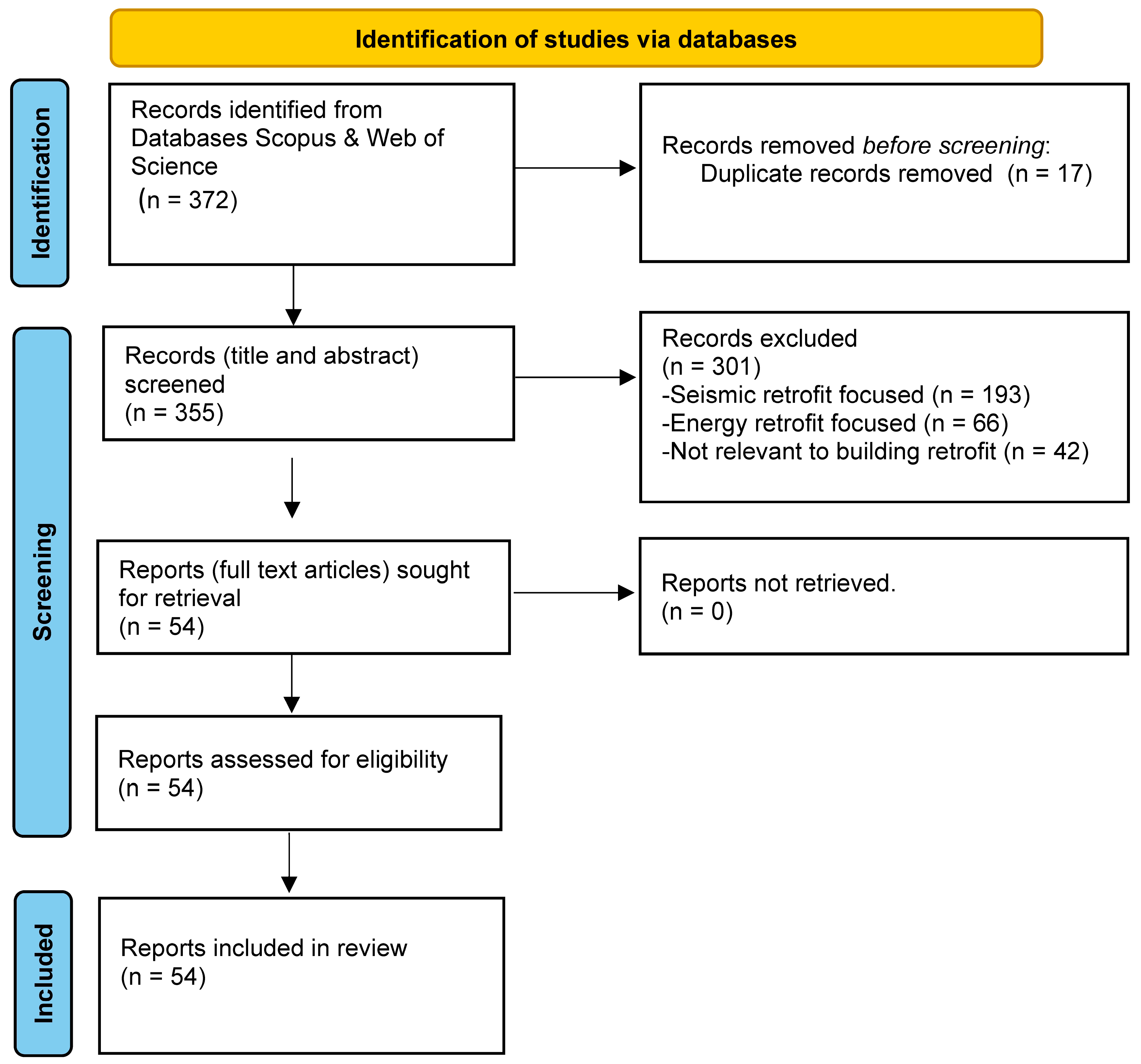
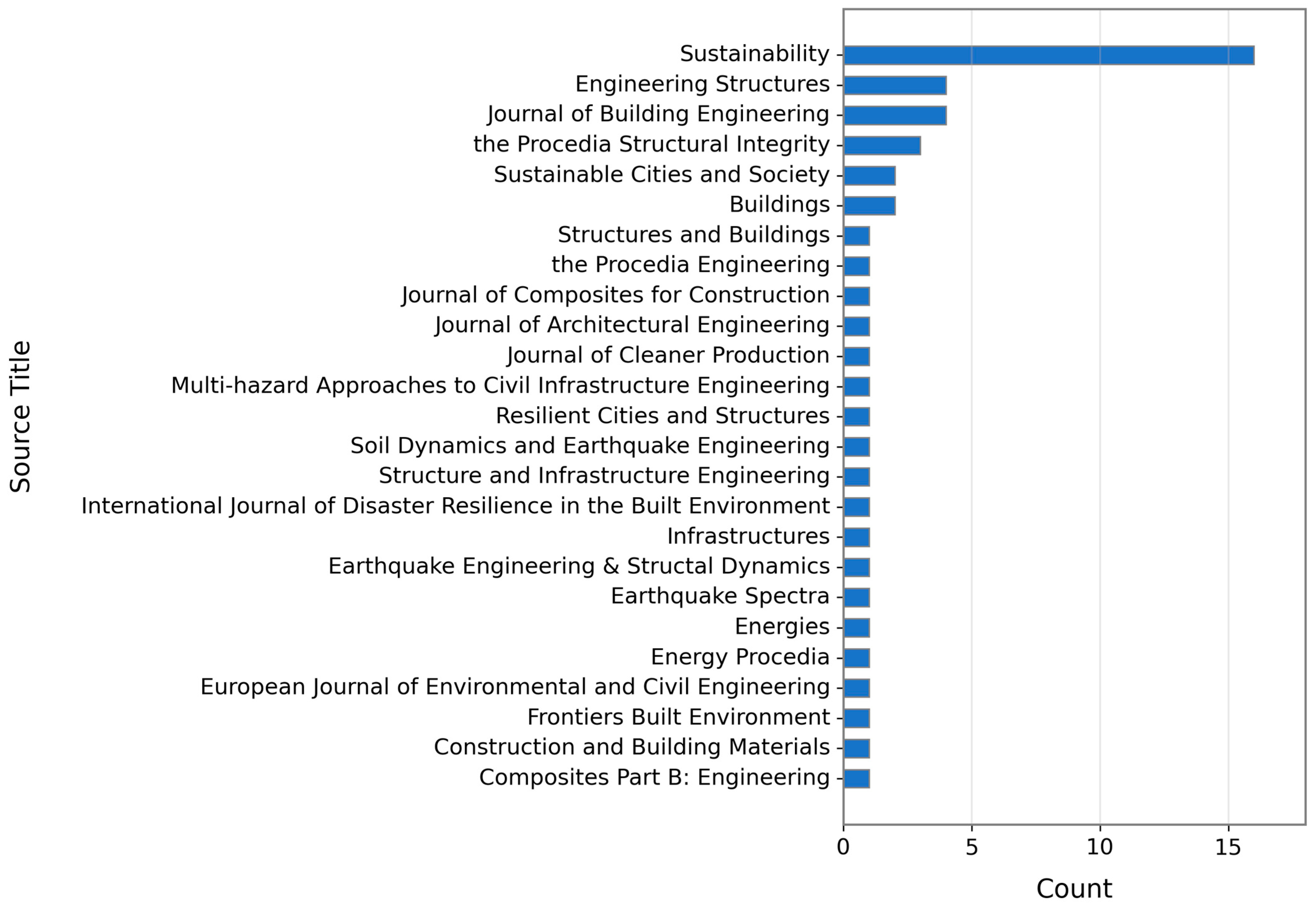
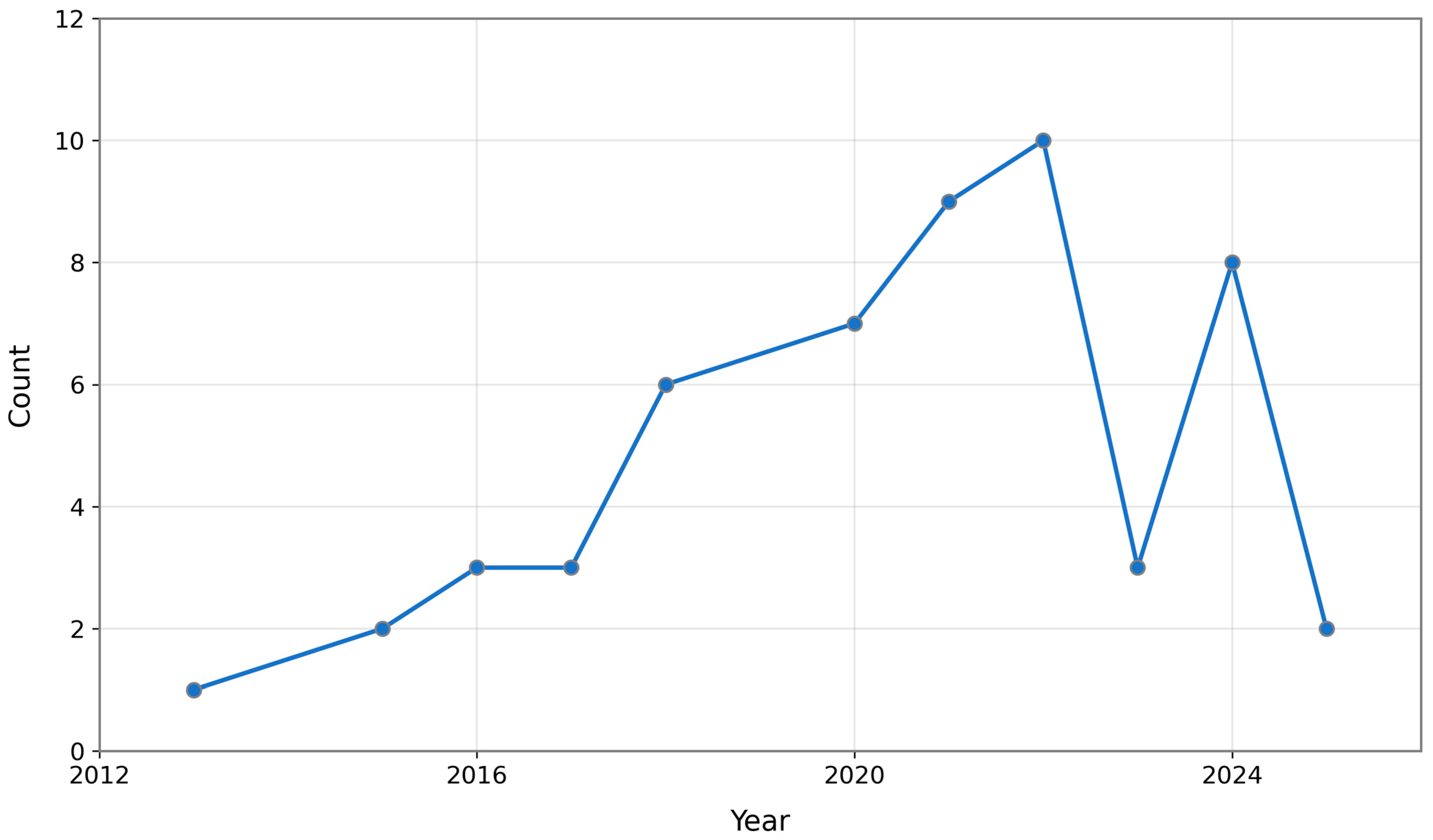
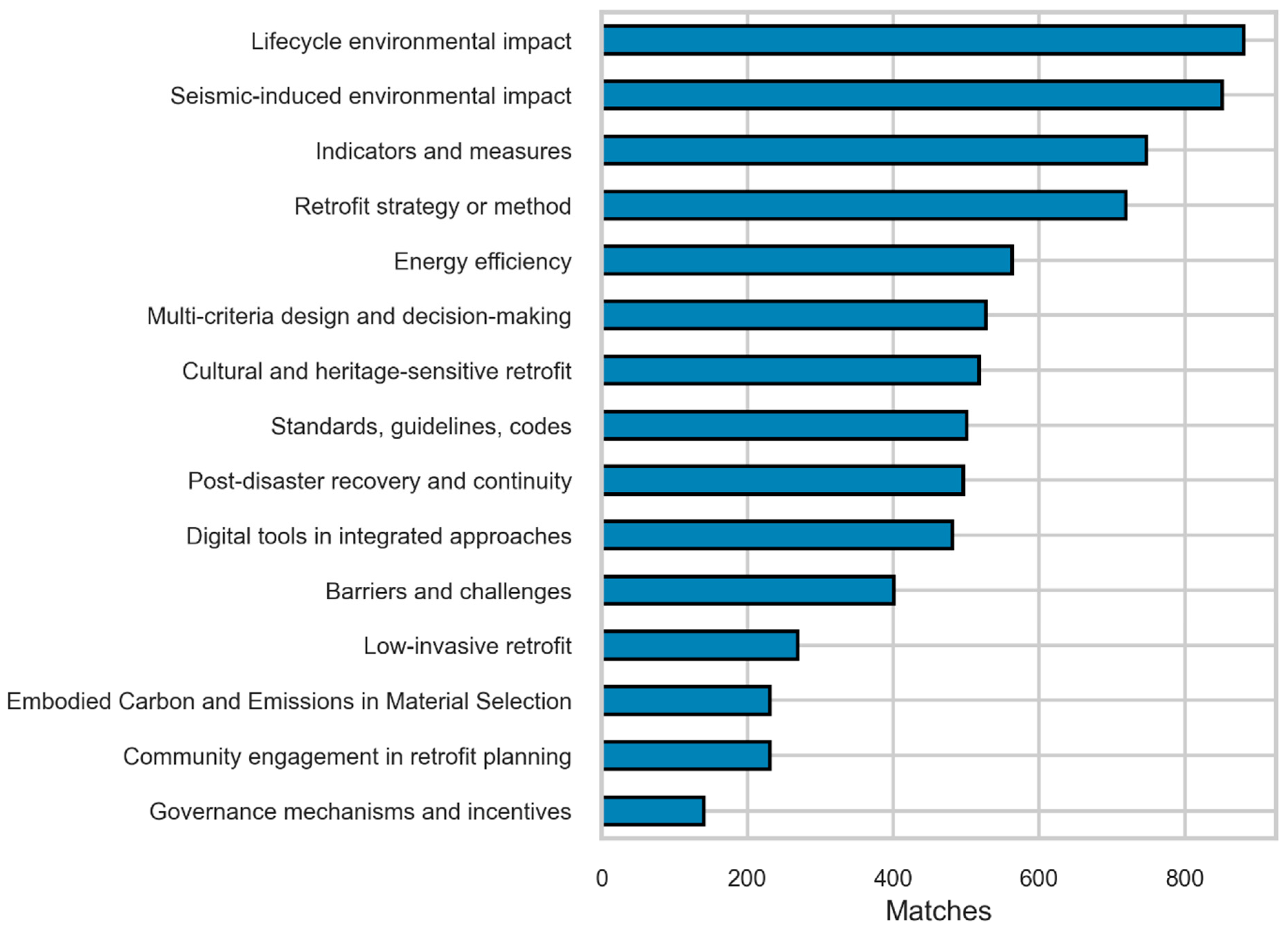
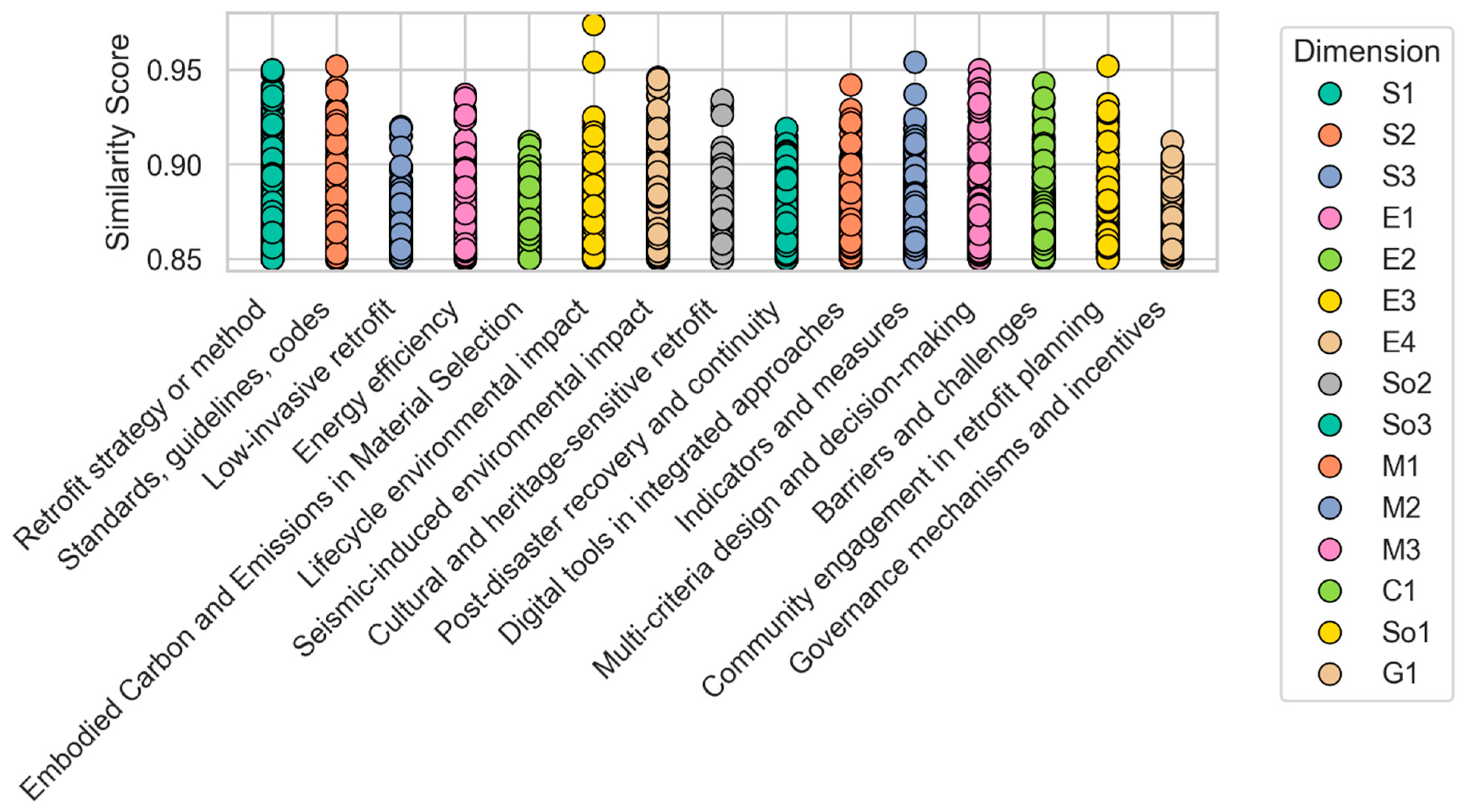
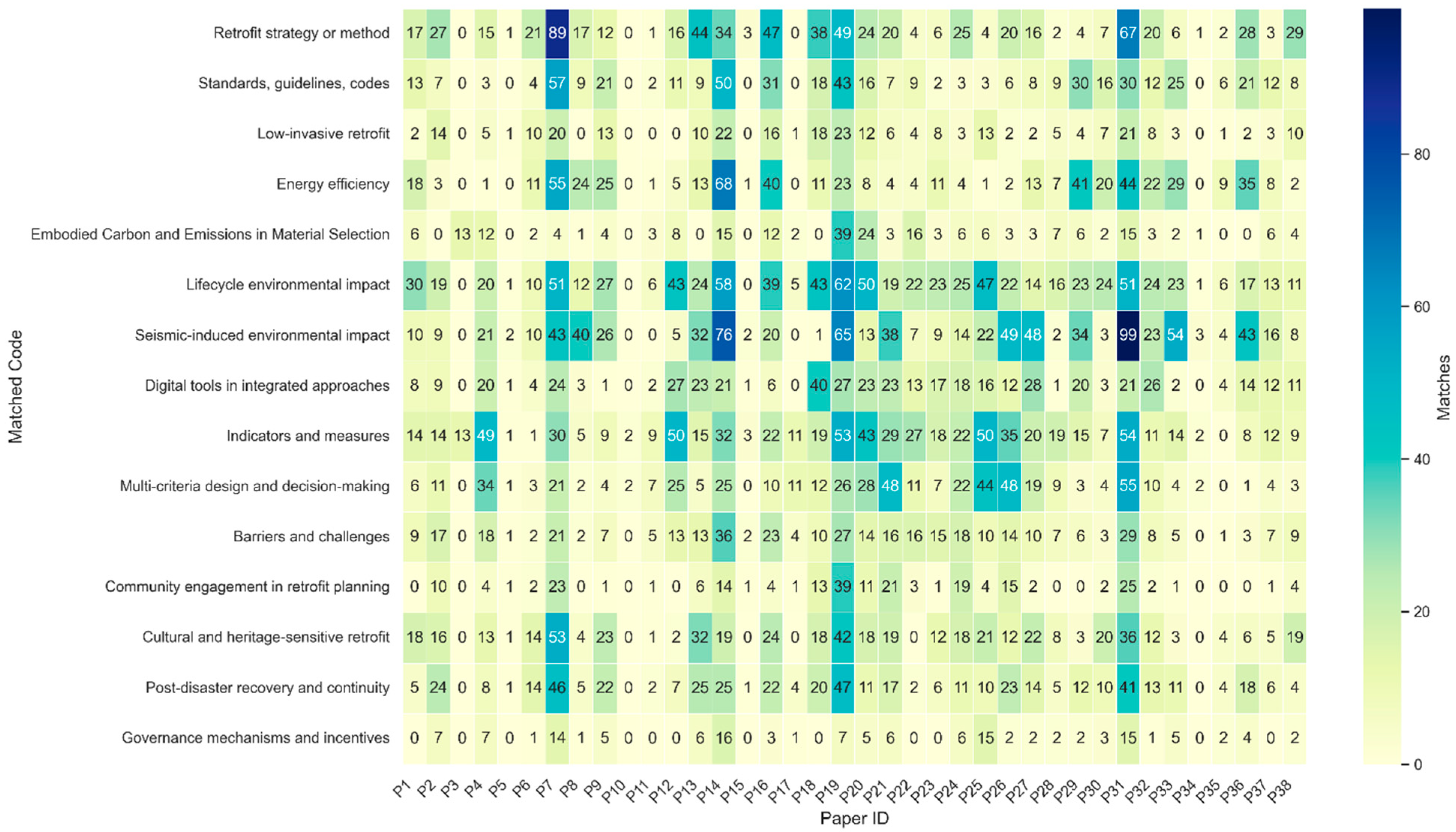
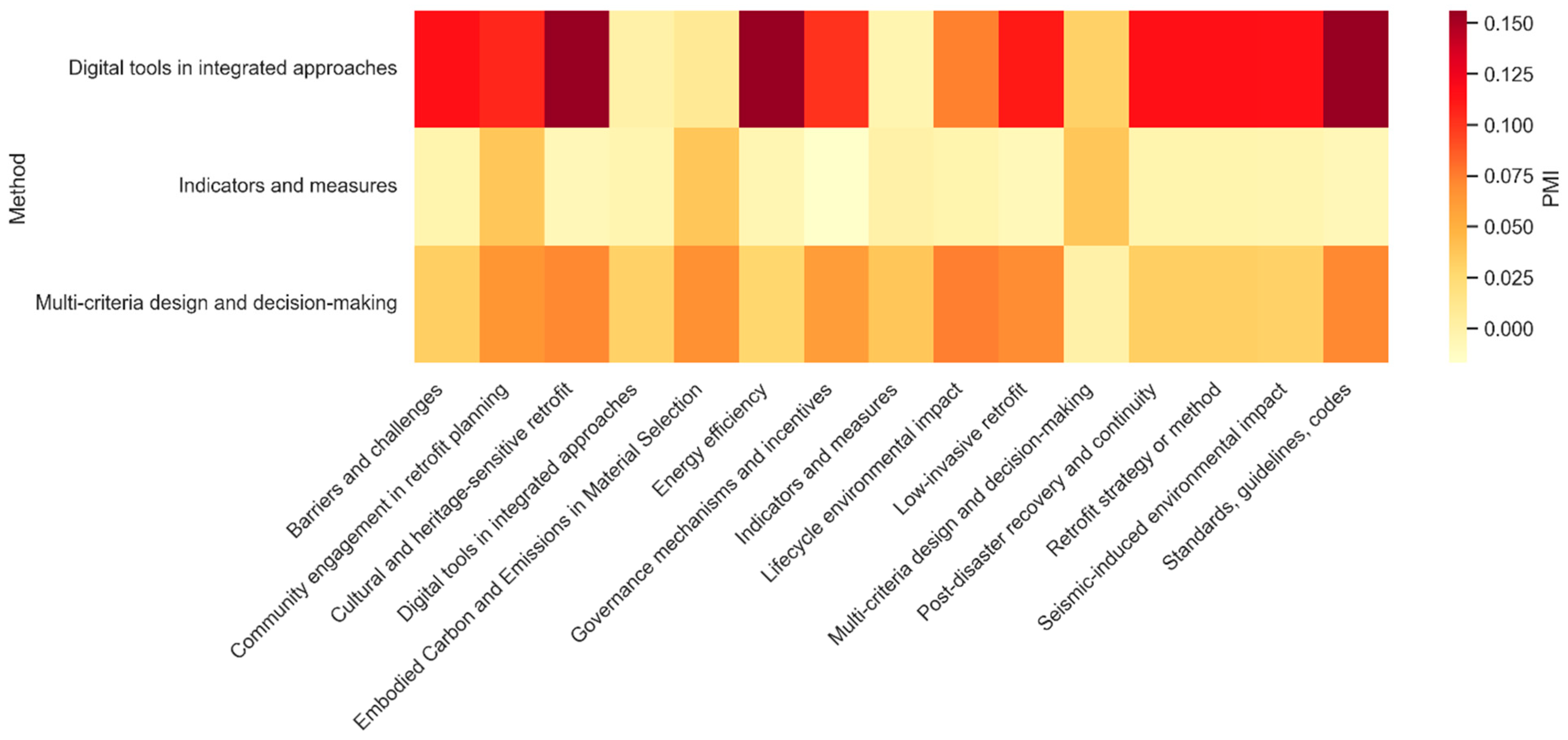
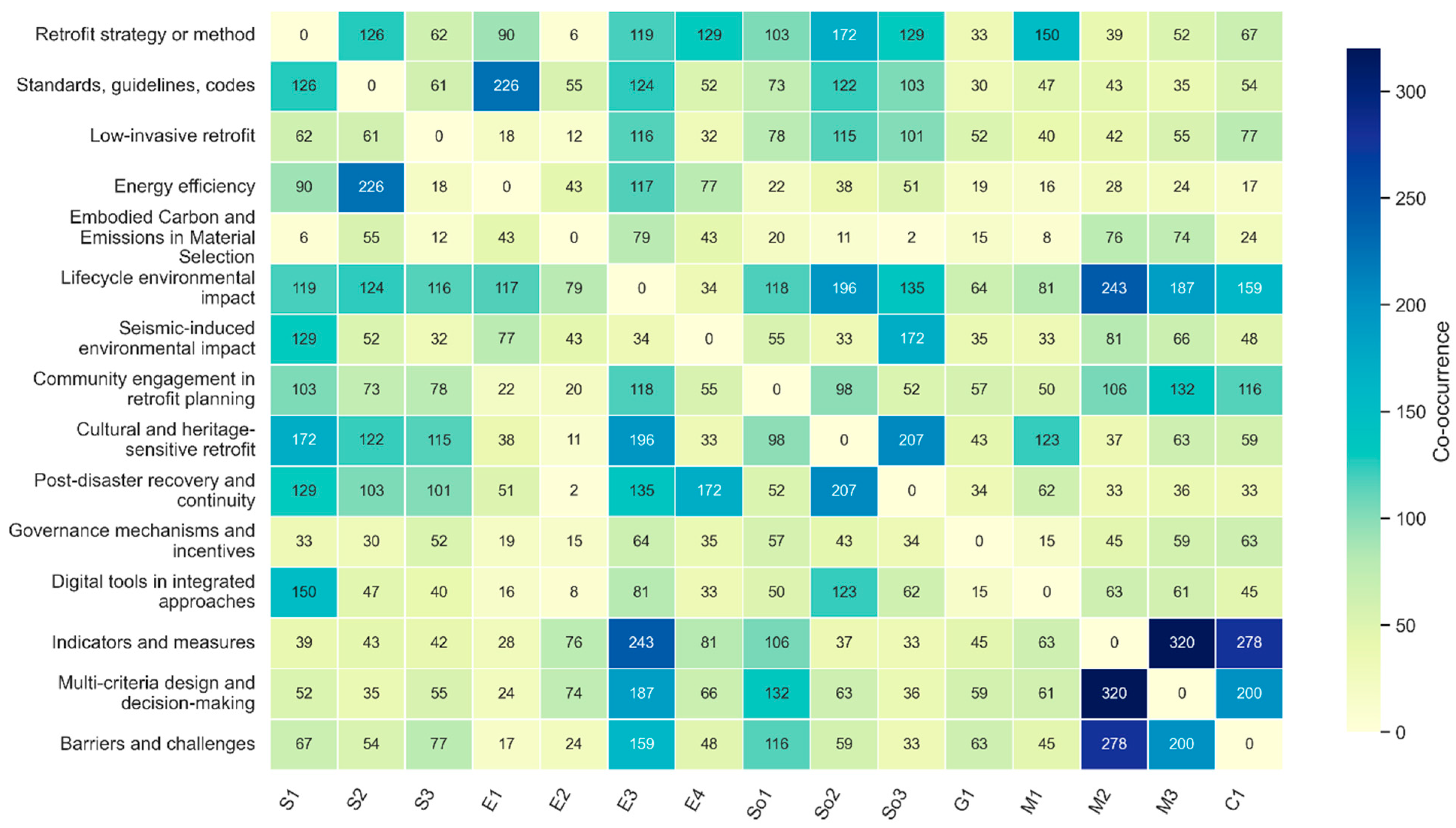
| Dimensions | Developed Codes |
|---|---|
| Structural dimension | “S1”, “Retrofit strategy or method”:
|
| Environmental dimension | “E1”, “Energy efficiency”:
|
| Social and governance dimension: | “So1”, “Community engagement in retrofit planning”:
|
| Approach and metrics: | “M1”, “Digital tools in integrated approaches”:
|
| Barriers and challenges | “C1”, “Barriers and challenges”:
|
| Strategy | Structural Indicators | Environmental/Economic Indicators | Typology and Implementation | Scalability/Stakeholders | References |
|---|---|---|---|---|---|
| Steel Exoskeleton Systems | Lateral load capacity ↑ 50–100%; seismic damage reduced, base shear ↑ by 1.5 | Cost EUR ~250–710/m2; high embodied CO2 than timber; but external application avoids demolition | RC frames, mid-rise residential; external installation, minimal disruption | Scalable in suburbs/low-density; limited by urban space constraints | Penazzato et al., 2024 [36] |
| RC Exoskeleton Systems | RC shell retrofits: stiffness ↑, deformation ↓, seismic capacity ↑ | Higher CO2 than steel/timber; longer intervention time; reduced reversibility | RC residential blocks (e.g., in Italy); may require new foundations | Less scalable due to time/cost; more possible for large blocks than small-scale projects | Pertile et al., 2021 [37] |
| CLT Panel Systems | lateral load capacity ↑ 25–50%; mitigates brittle RC failures (e.g., soft stories, short columns) | Cost EUR ~350–500/m2; lower embodied CO2 than steel; moderate thermal insulation (may need additional layers) | RC/masonry retrofits; can be external or internal (“nested buildings”) | Prefab, fast install, but less compatible with incremental retrofits or reparable retrofits | Penazzato et al., 2024 [36] |
| TRM Jacketing Systems | In-plane/out-of-plane wall strength ↑; lateral strength ↑ ~50% | Cost EUR ~80–115/m2, lower embodied CO2 than FRP; fire resistant, lower labour cost | RC and masonry envelopes; applied externally or internally | Demonstrated on EU residential buildings | Bournas 2018 [29] |
| Aluminium Insulation Panel Systems | Out-of-plane wall capacity ↑ ~49% after retrofit | Recyclable aluminium (low weight, corrosion resistant); insulation panels reduce thermal dispersion | Sandwich panels bolted with anchors for masonry walls | Prefabricated and fast to install; external application avoids disruption | Longobardi et al., 2024 [38] |
| Hybrid composites (Textile-Reinforced Concrete Panels (TCPs) and TRM Panels) | lateral strength ↑ ~30%; initial stiffness ↑ ~22%; improved displacement and energy dissipation | Prefabricated panels shorten downtime; embodied CO2 lower than RC jacketing | RC frames and masonry walls (tested in Korea-EU projects); prefabricated panels with textile reinforcement and capillary tubes | Prefab-ready; minimise onsite work/downtime | Baek et al., 2022 [33] |
| Barrier | Pathway to Address |
|---|---|
| Technical complexity and lack of standardised methods: Integration requires multidisciplinary expertise (structural + sustainability), no unified framework to link resilience and sustainability; existing standards (LEED, BREEAM, building codes) are discipline-oriented. Methods often rely on project-specific tools and specialised inputs. | Standardising metrics and tools: unified indicators and open-access toolkits, and collaboration among standards bodies, academia, and professional associations to provide replicable guidelines and develop cross-referenced standards. |
| Organisational silos and limited awareness: Structural/seismic experts, energy consultants, and policymakers rarely collaborate outside large projects. Local authorities lack capacity to evaluate integrated approaches. Owners remain unaware of long-term benefits. | Capacity building and awareness: Training programmes, cross-disciplinary curricula, and knowledge-sharing platforms to bridge silos. Targeted communication campaigns to inform owners and local authorities of long-term environmental, economic and safety gains. |
| Socio-cultural resistance and disruption concerns: Retrofit projects can cause displacement and financial concerns, especially in low-income or heritage sites. Communities fear loss of character, hidden costs, and disruptions to their lives. | Community engagement: Transparent communication, participatory design, and demonstration projects promoting heritage-sensitive retrofit strategies that balance safety with cultural preservation. |
| Fragmented policy and regulatory frameworks: Seismic codes and sustainability standards are governed by separate authorities, with misaligned policies and technical aspects. The roadmap of integrated retrofits for communities is unclear or not referenced. | Policy harmonisation and targeted financing: Unified permitting processes and bundled incentives. Expansion of programmes such as the European Green Deal and Italy’s EcoBonus to support integrated retrofit. |
| Data gaps and uncertainties: Many regions lack building inventories, lifecycle databases, or updated hazard models. Long-term uncertainties (climate, seismic frequency, energy costs). | Improved datasets and scenario planning: Investment in open-access building and material databases, updated hazard assessments, and integration of uncertainty modelling into retrofit decision making. |
Disclaimer/Publisher’s Note: The statements, opinions and data contained in all publications are solely those of the individual author(s) and contributor(s) and not of MDPI and/or the editor(s). MDPI and/or the editor(s) disclaim responsibility for any injury to people or property resulting from any ideas, methods, instructions or products referred to in the content. |
© 2025 by the authors. Licensee MDPI, Basel, Switzerland. This article is an open access article distributed under the terms and conditions of the Creative Commons Attribution (CC BY) license (https://creativecommons.org/licenses/by/4.0/).
Share and Cite
Karaki, G.; Hawileh, R.A. Integrated Building Retrofit for Seismic Resilience and Environmental Sustainability: A Critical Review. Buildings 2025, 15, 3800. https://doi.org/10.3390/buildings15203800
Karaki G, Hawileh RA. Integrated Building Retrofit for Seismic Resilience and Environmental Sustainability: A Critical Review. Buildings. 2025; 15(20):3800. https://doi.org/10.3390/buildings15203800
Chicago/Turabian StyleKaraki, Ghada, and Rami A. Hawileh. 2025. "Integrated Building Retrofit for Seismic Resilience and Environmental Sustainability: A Critical Review" Buildings 15, no. 20: 3800. https://doi.org/10.3390/buildings15203800
APA StyleKaraki, G., & Hawileh, R. A. (2025). Integrated Building Retrofit for Seismic Resilience and Environmental Sustainability: A Critical Review. Buildings, 15(20), 3800. https://doi.org/10.3390/buildings15203800







